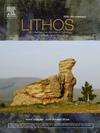Ordovician-Devonian multiple-phase subduction-accretion with crust-mantle interactions in the Proto-Tethys: Implications for plate driving mechanism
IF 2.9
2区 地球科学
Q2 GEOCHEMISTRY & GEOPHYSICS
引用次数: 0
Abstract
The tectonic evolution of the Proto-Tethys records the dispersal of the Gondwana and the formation of the Asian continent, based on which the driving force of plate tectonics was majorly attributed to slab pull. However, no consensus has been achieved on the driving force and some fundamental aspects of its geodynamic processes have been controversial. This study presents detailed petrological, geochronological, and geochemical analyses of northern West Kunlun Orogen (WKO) adakites to constrain subduction processes and the magma sources, advancing tectonic reconstruction of the Proto-Tethys. Two samples (OMS-60 and OMS-62) were collected from an ophiolitic mélange within the Omixia complex, where they occur in association with mafic rocks. Another sample (OMS-64) was obtained from a granitoid body located on the northern margin of this ophiolitic mélange. These samples yield zircon U-Pb ages of 399 ± 5 Ma, 434.0 ± 2 Ma, and 462 ± 3 Ma, displaying typical adakitic signatures (high Sr/Y = 49.6–193, LREE enrichment, HREE depletion) and variable isotopic compositions (εNd(t) = −8.42 to −0.78; εHf(t) = −3.97 to −0.51). These features indicate magma generation through partial melting of Proto-Tethys oceanic crust and overlying sediments, coupled with mantle interaction during ascent. Combined with regional data, two adakite groups are identified: (1) northern 462–443 Ma suites formed during northward subduction, and (2) younger 434–399 Ma suites within of the Omixia complex linked to southward subduction. The sequential subduction regimes, potentially driven by ridge subduction or slab tearing, promoted oceanic crust melting and high-SiO₂ magma emplacement in forearc accretionary prisms. These findings, corroborated by regional evidence, challenge slab-pull dominance and instead support a hybrid geodynamic mechanism involving back-arc rifting and multi-force interactions. This work resolves Proto-Tethys subduction polarity shifts and provides new constraints on arc-related crust-mantle processes during Ordovician-Devonian orogenesis.

原特提斯奥陶系-泥盆系多期俯冲-增生与壳幔相互作用:对板块驱动机制的启示
原特提斯的构造演化记录了冈瓦纳大陆的分散和亚洲大陆的形成,在此基础上,板块构造的驱动力主要是板块拉力。然而,对其驱动力尚未达成共识,其地球动力学过程的一些基本方面一直存在争议。本文对西昆仑造山带北部埃达克岩进行了详细的岩石学、年代学和地球化学分析,以限制俯冲过程和岩浆来源,推进原特提斯构造重建。两个样品(OMS-60和OMS-62)是从奥米夏复合体内的蛇绿质岩石中收集的,它们与基性岩石一起出现。另一个样品(OMS-64)来自于位于该蛇绿岩样区域北缘的花岗岩体。样品的锆石U-Pb年龄分别为399±5 Ma、434.0±2 Ma和462±3 Ma,具有典型的绿质特征(高Sr/Y = 49.6 ~ 193, LREE富集,HREE亏缺)和多变的同位素组成(εNd(t) =−8.42 ~−0.78;εHf(t) = - 3.97 ~ - 0.51)。这些特征表明岩浆是通过原特提斯洋壳和上覆沉积物的部分熔融以及上升过程中地幔的相互作用产生的。结合区域资料,确定了两个埃达奇岩组:(1)北部462 ~ 443 Ma组形成于北俯冲时期;(2)奥米夏杂岩内较年轻的434 ~ 399 Ma组形成于南俯冲时期。序贯的俯冲机制可能受脊俯冲或板块撕裂的驱动,促进了洋壳熔融和高sio2岩浆侵位于弧前增生棱柱。这些发现受到了区域证据的证实,挑战了板拉主导地位,转而支持了一种涉及弧后裂陷和多力相互作用的混合地球动力学机制。这项工作解决了原特提斯俯冲极性转移问题,为奥陶系—泥盆系造山过程中弧相关壳幔过程提供了新的约束条件。
本文章由计算机程序翻译,如有差异,请以英文原文为准。
求助全文
约1分钟内获得全文
求助全文
来源期刊

Lithos
地学-地球化学与地球物理
CiteScore
6.80
自引率
11.40%
发文量
286
审稿时长
3.5 months
期刊介绍:
Lithos publishes original research papers on the petrology, geochemistry and petrogenesis of igneous and metamorphic rocks. Papers on mineralogy/mineral physics related to petrology and petrogenetic problems are also welcomed.
 求助内容:
求助内容: 应助结果提醒方式:
应助结果提醒方式:


